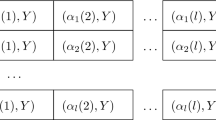Summary
Introduced by Lawrie, the Omega network is a powerful device to connect processing elements in a SIMD computer or in a multiprocessor architecture. Unfortunately it is not rearrangeable and some permutations that are frequently used to align data in a SIMD computer cannot be performed in one pass. Such is the case with the class of permutations induced by a permutation of index digits (PIPID) which includes the perfect shuffle, the bit reversal, etc. ... Using the techniques of linear algebra over the two-element field, we show that PIPIDs can be achieved by the Omega network through which the vector of data is routed twice.
Similar content being viewed by others
References
Andresen, S.: The looping algorithm extended to base 2r rearrangeable switching networks. IEEE Trans. Commun. COM-25, 1057–1063 (1977)
Auguin, M., Larbey, F.: OPSILA: an advanced SIMD computer for numerical analysis and signal processing. Euromicro (1984)
Backus, J.: Function-level computing. IEEE Spectrum 19, 22–27 (1982)
Barnes, G.H., Brown, R.M., Kato, M., Kuck, D.J., Slotnick, D.L., Stokes, R.A.: The ILLIAC IV computer. IEEE Trans. Comput. C-17, 746–757 (1968)
Batcher, K.E.: Sorting networks and their applications. In: Spring Joint Comput. Conf. Proc., vol. 32, pp. 307–314. Montvale, N.J.: AFIPS Press 1968
Batcher, K.E.: STARAN parallel processor system hardware. In: Fall Joint Comput. Conf. Proc., vol. 43, pp. 405–410. Montvale, N.J.: AFIPS Press 1974
Batcher, K.E.: The flip network in STARAN. Proc. 1976 Int. Conf. Parallel Processing, pp. 65–71, 1976
Batcher, K.E.: Bit-serial parallel processing systems. IEEE Trans. Comput. C31, 377–384 (1982)
Benes, V.E.: Mathematical theory of connecting networks and telephone traffic. New York: Academic Press 1968
Burroughs, Corp.: Final report: NASF feasibility study — NASA Contractor Report NAS2-9897 (1979)
Dennis, J.B.: Data flow supercomputers. Computer 13, 48–56 (1980)
Feierbach, G., Stevenson, D.: A feasibility study of programmable switching networks for data routing. Phoenix project, Memorandum 007, Institute for Advanced Computation, Sunnyvale, California (1977)
Feierbach, G., Stevenson, D.: The Phoenix Project. Infotech State of the Art Report: Supercomputers, vol.2, pp. 91–115. Maidenhead: Infotech Intl Ltd, 1979
Fraser, D.: Array permutation by index-digit permutation. J. Assoc. Comput. Mach. 23, 298–308 (1976)
Golomb, S.W.: Permutations by cutting and shuffling. SIAM Rev. 3, 293–297 (1961)
Hockney, R.W., Jesshope, C.R.: Parallel Computers. Bristol: Adam Hilger 1981
Kuck, D.J., Stokes, R.A.: The Burroughs Scientific Processor (BSP). IEEE Trans. Comput. C-31, 363–376 (1982)
Lang, T., Stone, H.S.: A shuffle-exchange network with simplified control. IEEE Trans. Comput. C-25, 55–65 (1976)
Lawrie, D.H.: Access and alignement of data in an array computer. IEEE Trans. Comput. C-24, 1145–1155 (1975)
Lawrie, D.H., Vora, C.R.: The prime memory system for array access. IEEE Trans. Comput. C-31, 435–442 (1982)
Lenfant, J.: Commande d'un réseau de connexion pour calculateur parallèle. Comptes-Rendus de l'Académie des Sciences, série 1, tome 284, Paris 1977
Lenfant, J.: Parallel permutations of data: a Benes network control algorithm for frequently used permutations. IEEE Trans. Comput. C-27, 637–647 (1978)
Lenfant, J., Tahe, S.: Permuting data with the Omega network. RADC final report, 1978
Orcutt, S.E.: Implementation of permutation functions in ILLIAC IV-type computers. IEEE Trans. Comput. C-25, 929–936 (1976)
Reddaway, S.F.: The DAP approach. Infotech State of the Art Report: Supercomputers, vol. 2, pp. 311–329. Maidenhead: Infotech Intl. 1979
Shapiro, H.D.: Theoretical limitations on the efficient use of parallel memories. IEEE Trans. Comput. C-27, 421–428 (1978)
Siegel, H.J.: Analysis techniques for SIMD machine interconnection networks and the effect of processor address masks. IEEE Trans. Comput. C-26, 153–161 (1977)
Stone, H.S.: Parallel processing with the perfect shuffle. IEEE Trans. Comput. C-20, 153–161 (1971)
Sumney, L.W.: VHSIC: a status report. IEEE Spectrum 19, 34–39 (1982)
Wilkinson, J.H.: The algebraic eigenvalue problem. London: Oxford University Press 1965
Yew, P.C., Lawrie, D.H.: An easily controlled network for frequently used permutations. Proc. Workshop on interconnection networks, pp. 72–73, 1980
Author information
Authors and Affiliations
Rights and permissions
About this article
Cite this article
Lenfant, J., Tahé, S. Permuting data with the Omega network. Acta Informatica 21, 629–641 (1985). https://doi.org/10.1007/BF00289714
Received:
Issue Date:
DOI: https://doi.org/10.1007/BF00289714



